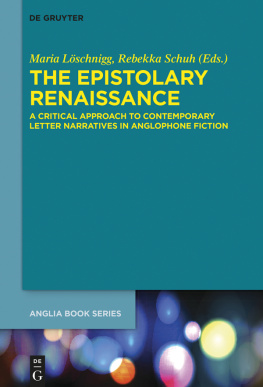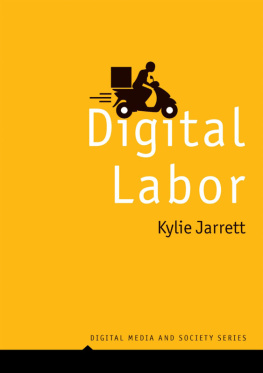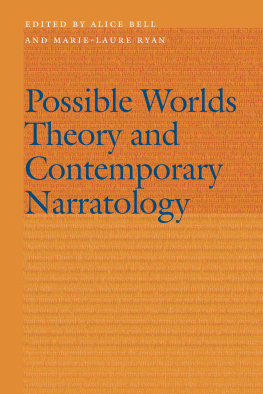This book used to be a clutter of Word and Open Office documents or maybe even TextEdit files that used to be Notes on my phones or notes scribbled on legal pads and the back of envelopes. Once the process is a product, well, I guess thats the moment of letting go.
My own work in progress could have not ever be turned into a book without the generosity and support of Laura Bieger and Frank Kelleter, to whom I am deeply thankful for their encouragement and trust throughout the years. Gabi Bodmeier, David Bosold, and my colleagues and fellow cohort members of the Graduate School of North American Studies have been supportive since I started working on this project in 2012. Thanks to my students and colleagues in Frankfurt for their fresh perspectives on old ideas. Johannes Voelz and Bernd Herzogenrath have given me new thoughts and inspiration for this projectand for projects to come. Thank you to Patricia Pisters. At Bloomsbury, thanks to Katie Gallof and Erin Duffy. For my family and my friends: thank you for taking care of me. Thanks to the wonderful Joshua Rahtz. Thank you to Maria Sulimma for rocket coffee and units. Unending modern thanks to Sarah Wasserman; your help and support means more than you can imagine.
I am grateful for having been able to present my ideas during workshops and conferences at FU Berlin, Johns Hopkins University, Ohio State University, University of Freiburg, University of Delaware, University of Erfurt, and Goethe-University Frankfurt.
Copyright acknowledgments
Chapter 2: Images of the Multi-Story Building Model used with permission by Drawn and Quarterly (thanks to Peggy Burns)
Chapter 3: The cover of Title of This Song from Song Reader used with permission by McSweeneys (thanks to Kristina Kearns); Beck cut outs used with permission by the artist (thanks to Ham); Creative Commons licensing for the Beck concert photograph (image by Scott Beale/Laughing Squidlaughingsquid.com)
Chapter 4: Screengraps from Kentucky Route Zero used with permission by Cardboard Computer (thanks to the Cardboard Computer team)
On June 1, 2016, a New York Times headline proclaimed, Its Official: The Internet Is Over. Oh no, I thought, looking up from the news app on my beaten up iPhone 4screen cracked, loading time slow like honey, storage full. But the internet did not fall out of style in the summer of 2016, instead, The New York Times joined The Associated Press in a changing of their style rule: to lowercase the term the internet. This small change, so the announcement went, facilitates a smoother reading flow for the peruser of the newspaper. But the choice to lowercase the term signals a broader shift in the understanding of the internet in everyday life. It suggests that the internet is not a new medium anymore: it is a common tendency to capitalize newly coined or unfamiliar terms. Once a term becomes familiar and quotidian, there is a tendency to drop the capital letter, as the announcement says (Corbett 2016, n.p.). The dropping of its capital letter by the year 2016 marks the moment the internet turned into a familiar and commonplace medium that orchestrates life, love, and laborit is not new anymore but has created routines, habits, and addictions for many users. In this book I turn toward cultural objects that emerge around this very moment when the capital letter I slowly made way for the lowercase i, when the internet started to be culturally coded as commonplace and ordinary. I am interested in this shift toward a restructuring of an ever-present present, or, rather, a present that keeps on refreshing itself. Work in Progress: Curatorial Labor in Twenty-First-Century American Fiction aligns a conceptual rock album, a glitchy computer game, and an incomplete graphic narrative that toy with the dichotomy of staging themselves as digital media that remain decidedly offline and retro, working with the implications of commonplace media and retro newness.
The three case studies I turn to in this book incorporate and reject digital forms and practicesthey borrow what they need not to replicate online experience, but to make it both legible and unfamiliar. In each chapter, I attempt to tease out the traces of earlier forms that reside in the newer ones: nineteenth-century sheet music in a twenty-first-century DIY musical release; the antiquated paper cut out inside a digitally reproduced graphic-novel-in-a-box; DOS code from the 1980s appearing on the screen of a MacBookthese are medial oddities that become visible when we pay close attention by excavating the old from within the new. This helps to fully understand the layers of meaning that these objects encode and the experiences they make available: It is my assertion in this project that we must think of the object and the reader as flirting, knowingly or unknowingly, with the ghosts of the past. This relay between old and new is not limited to the texts mediality. As decidedly contemporary texts, they combine recent innovations in printing, computing, and distribution with familiar modes of storytelling and reader engagement. Whether or not the reader of Beck Hansens Song Reader knows much about nineteenth-century sheet music, the practices of reading, rehearsing, or performing nonetheless recall earlier modes of musical production encapsulated within practices enabled by YouTube or MP3s on our mobile devices. Whether or not the reader of Kentucky Route Zero is able to write code or is savvy in earlier computer technologies, she still surreptitiously, maybe unbeknownst to her, reproduces online activity by selecting pre-given options on the screen. She may easily be overwhelmed by the meandering plotline and the design of the computer game; she will, however, rely on familiar reading strategies of character identification, suture and closure, and following the plot.
But how does one begin even theorizing and interpreting works that emerge in this very moment of lowercasing the internet? What is the appropriate method for a first responder? It has been tempting in examining these texts from 2012 and 2013 to rely on Fredric Jamesons famous mandate to always historize. In Work in Progress I do indeed often trace the historical developmentstechnological or aestheticthat have led up to these current objects. But in the process of excavating the meaning from these texts, I have come to see that thinking in timelines and historical arcs may in fact be inadequate. These texts, when they are invested in the past, are invested in modes that cannot be neatly called nostalgic, historical, and retro. Instead, they are often all of these things at once, while also staging themselves as hip and new. I am therefore less concerned with how a given work might have developed from a previous one and more interested in how a contemporary work might be said to contain an earlier one. This cadence of meaning is indicative, and I take my methodological cues from recent work in media studies by scholars such as Wolfgang Ernst, Lisa Gitelman, and John Durham Peters. In her book Always Already New (published in 2008), Lisa Gitelman claims that media are always historical subjects. By historical Gitelman means that even the newest new media today come from somewhere (Gitelman 2008, 5). But she also insists that media are historical because they are functionally integral to a sense of pastness. Not only do people regularly learn about the past by means of media representationsbooks, films, and so onusing media also involves implicit encounters with the past that produced the representations in question (Gitelman 2008, 5). I am convinced by her second pointthe objects that I look at can rightly be called new, however, they also offer encounters with past, older incarnations. A text such as Building Stories , for example, could be read as the twenty-first centurys result of a long history of comic books, dime novels, and graphic novels. But an analysis of Building Stories as an incomplete text that asks its readers to become collectors relies rather on the way that Wares graphic narrative recalls the board game, the archive, and the collectionthis approach can therefore unveil strategies of the texts that would otherwise remain invisible or opaque.












